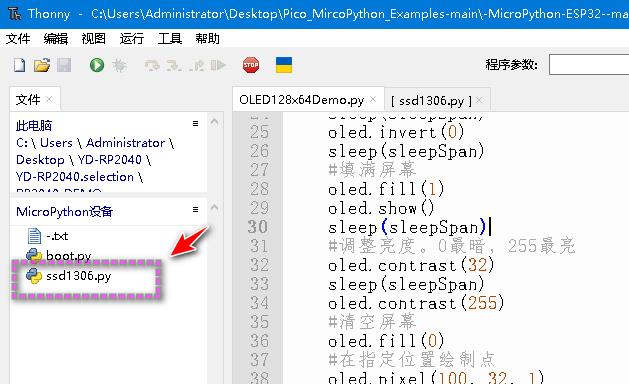MicroPython ESP32ssd1306驱动0.96“I2C屏幕显示
Posted perseverance52
tags:
篇首语:本文由小常识网(cha138.com)小编为大家整理,主要介绍了MicroPython ESP32ssd1306驱动0.96“I2C屏幕显示相关的知识,希望对你有一定的参考价值。
【MicroPython ESP32】ssd1306驱动0.96"I2C屏幕显示
- 本示例基于
Thonny平台开发 - 效果演示

所需模块micropython-ssd1306模块
- 中文下载站:
https://www.cnpython.com/pypi/micropython-ssd1306/download - 官方下载站:
https://pypi.org/project/micropython-ssd1306/
也可以不下载,将下面的代码拷贝下来,保存名为
ssd1306.py,将文件保存到MicroPythonESP32设备上。
ssd1306.py
# MicroPython SSD1306 OLED driver, I2C and SPI interfaces
from micropython import const
import framebuf
# register definitions
SET_CONTRAST = const(0x81)
SET_ENTIRE_ON = const(0xA4)
SET_NORM_INV = const(0xA6)
SET_DISP = const(0xAE)
SET_MEM_ADDR = const(0x20)
SET_COL_ADDR = const(0x21)
SET_PAGE_ADDR = const(0x22)
SET_DISP_START_LINE = const(0x40)
SET_SEG_REMAP = const(0xA0)
SET_MUX_RATIO = const(0xA8)
SET_COM_OUT_DIR = const(0xC0)
SET_DISP_OFFSET = const(0xD3)
SET_COM_PIN_CFG = const(0xDA)
SET_DISP_CLK_DIV = const(0xD5)
SET_PRECHARGE = const(0xD9)
SET_VCOM_DESEL = const(0xDB)
SET_CHARGE_PUMP = const(0x8D)
# Subclassing FrameBuffer provides support for graphics primitives
# http://docs.micropython.org/en/latest/pyboard/library/framebuf.html
class SSD1306(framebuf.FrameBuffer):
def __init__(self, width, height, external_vcc):
self.width = width
self.height = height
self.external_vcc = external_vcc
self.pages = self.height // 8
self.buffer = bytearray(self.pages * self.width)
super().__init__(self.buffer, self.width, self.height, framebuf.MONO_VLSB)
self.init_display()
def init_display(self):
for cmd in (
SET_DISP | 0x00, # off
# address setting
SET_MEM_ADDR,
0x00, # horizontal
# resolution and layout
SET_DISP_START_LINE | 0x00,
SET_SEG_REMAP | 0x01, # column addr 127 mapped to SEG0
SET_MUX_RATIO,
self.height - 1,
SET_COM_OUT_DIR | 0x08, # scan from COM[N] to COM0
SET_DISP_OFFSET,
0x00,
SET_COM_PIN_CFG,
0x02 if self.width > 2 * self.height else 0x12,
# timing and driving scheme
SET_DISP_CLK_DIV,
0x80,
SET_PRECHARGE,
0x22 if self.external_vcc else 0xF1,
SET_VCOM_DESEL,
0x30, # 0.83*Vcc
# display
SET_CONTRAST,
0xFF, # maximum
SET_ENTIRE_ON, # output follows RAM contents
SET_NORM_INV, # not inverted
# charge pump
SET_CHARGE_PUMP,
0x10 if self.external_vcc else 0x14,
SET_DISP | 0x01,
): # on
self.write_cmd(cmd)
self.fill(0)
self.show()
def poweroff(self):
self.write_cmd(SET_DISP | 0x00)
def poweron(self):
self.write_cmd(SET_DISP | 0x01)
def contrast(self, contrast):
self.write_cmd(SET_CONTRAST)
self.write_cmd(contrast)
def invert(self, invert):
self.write_cmd(SET_NORM_INV | (invert & 1))
def show(self):
x0 = 0
x1 = self.width - 1
if self.width == 64:
# displays with width of 64 pixels are shifted by 32
x0 += 32
x1 += 32
self.write_cmd(SET_COL_ADDR)
self.write_cmd(x0)
self.write_cmd(x1)
self.write_cmd(SET_PAGE_ADDR)
self.write_cmd(0)
self.write_cmd(self.pages - 1)
self.write_data(self.buffer)
class SSD1306_I2C(SSD1306):
def __init__(self, width, height, i2c, addr=0x3C, external_vcc=False):
self.i2c = i2c
self.addr = addr
self.temp = bytearray(2)
self.write_list = [b"\\x40", None] # Co=0, D/C#=1
super().__init__(width, height, external_vcc)
def write_cmd(self, cmd):
self.temp[0] = 0x80 # Co=1, D/C#=0
self.temp[1] = cmd
self.i2c.writeto(self.addr, self.temp)
def write_data(self, buf):
self.write_list[1] = buf
self.i2c.writevto(self.addr, self.write_list)
class SSD1306_SPI(SSD1306):
def __init__(self, width, height, spi, dc, res, cs, external_vcc=False):
self.rate = 10 * 1024 * 1024
dc.init(dc.OUT, value=0)
res.init(res.OUT, value=0)
cs.init(cs.OUT, value=1)
self.spi = spi
self.dc = dc
self.res = res
self.cs = cs
import time
self.res(1)
time.sleep_ms(1)
self.res(0)
time.sleep_ms(10)
self.res(1)
super().__init__(width, height, external_vcc)
def write_cmd(self, cmd):
self.spi.init(baudrate=self.rate, polarity=0, phase=0)
self.cs(1)
self.dc(0)
self.cs(0)
self.spi.write(bytearray([cmd]))
self.cs(1)
def write_data(self, buf):
self.spi.init(baudrate=self.rate, polarity=0, phase=0)
self.cs(1)
self.dc(1)
self.cs(0)
self.spi.write(buf)
self.cs(1)
Ctrl + Shift +S先将ssd1306.py保存到设备当中


示例代码
from machine import Pin
import machine
from utime import sleep
from ssd1306 import SSD1306_I2C
sleepSpan=1.5
sda=Pin(25)
scl=Pin(26)
i2c=machine.I2C(0,sda=sda,scl=scl,freq=400000)
oled=SSD1306_I2C(128,64,i2c)
while True:
#在指定位置显示文字 str x y
oled.text("Perseverance51",8,5)
oled.text("Hello world!",15,20)
oled.text("MicroPython",20,36)
oled.text("hi!ESP32",26,52)
oled.show()
sleep(sleepSpan)
#奇数时反相显示,偶数时正常显示
oled.invert(1)
sleep(sleepSpan)
oled.invert(0)
sleep(sleepSpan)
#填满屏幕
oled.fill(1)
oled.show()
sleep(sleepSpan)
#调整亮度。0最暗,255最亮
oled.contrast(32)
sleep(sleepSpan)
oled.contrast(255)
#清空屏幕
oled.fill(0)
#在指定位置绘制点
oled.pixel(100, 32, 1)
oled.line(5,5,123,5,1)
oled.rect(15,15,80,40,1)
oled.fill_rect(25,25,40,20,1)
oled.show()
sleep(sleepSpan)
#清空屏幕
oled.fill(0)
oled.show()
sleep(sleepSpan)
以上是关于MicroPython ESP32ssd1306驱动0.96“I2C屏幕显示的主要内容,如果未能解决你的问题,请参考以下文章